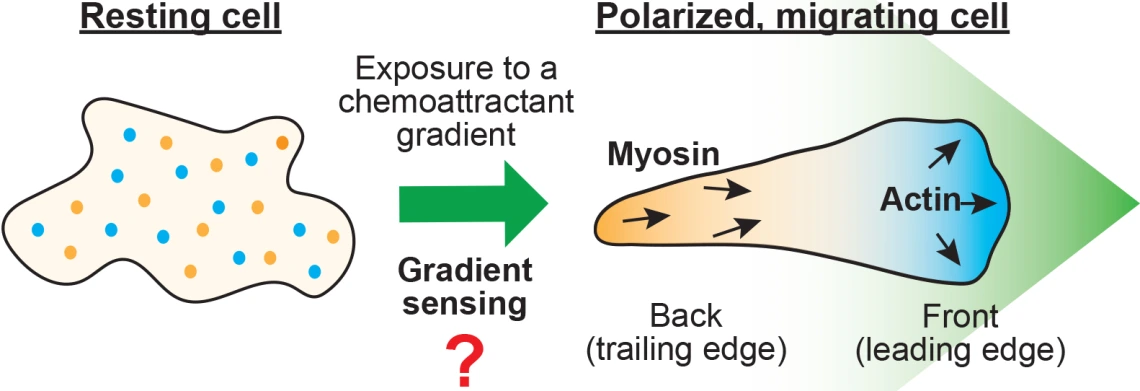Dr. Charest Receives $1.6m NSF Grant!

Grant Title: The role of receptor dynamics in eukaryotic chemotaxis
PI: Pascale Charest, University of Arizona
Co-I: Wouter-Jan Rappel, UCSD
Award: $1,648,162
Grant Awarded by NSF
Pascale Charest, Associate Professor, Molecular and Cellular Biology, University of Arizona, and Wouter-Jan Rappel, Distinguished research scientist at UC San Diego were recently awarded a grant from the National Science Foundation (NSF). This $1.6m grant will fund a project that will provide unprecedented insight into how different types of motile cells are able to detect gradients of chemicals (chemoattractants) and migrate towards the source, which is how many microorganisms find food and what guides immune cells to sites of inflammation or infection during the immune response in mammals. This important cellular behavior is termed chemotaxis and is not understood. Through an unknown mechanism, highly motile cells such as the amoeba Dictyostelium discoideum and mammalian white blood cells can detect a chemoattractant gradient that is as small as a 2% difference between the front and back of the cells, but how cells achieve such gradient sensing is not known. Using Dictyostelium as an experimental model, this project will uncover an important aspect of the gradient sensing machinery and how it functions to control the migration of cells. In addition, the project will strongly emphasize providing multidisciplinary research training, laboratory experiences, and mentorship to high school and undergraduate students in both California and Arizona, particularly reaching out to underrepresented groups. This will be achieved through partnerships with local schools as well as the development of an undergraduate colloquium course aimed at preparing and engaging students in scientific research early in their undergraduate career.
To gain a better understanding of how Dr. Charest and Wouter-Jan Rappel intend to engage high school and undergraduate students in their research, I met with Dr. Charest to discuss the specifics of the grant. Below are the questions and answers from my conversation with Dr. Charest.
Why did you focus the grant on including mentorship to high school and undergraduate students?
We wanted to focus our project’s broader impacts on this because many students don’t know that being a scientist is a possible career path for them until much later in their studies, if ever, and we wanted to reach these students to introduce them to scientific research. These efforts are also motivated by studies that showed that students majoring in science are more likely to remain in their major and successfully graduate if they become involved in research, and that the earlier they engage in research, the better the outcome.
When does the grant / research start?
The grant officially started August 1, 2024, and we’re already working on the project!
Why did you choose this topic?
There is an important knowledge gap concerning how cells detect chemoattractant gradients, especially concerning the role of the receptors, which are often G protein-coupled receptors (GPCRs). I studied GPCRs extensively during my PhD and always wanted to look deeper into the roles of these receptors in chemotaxis, which I think still have a lot to reveal. Using new technology and our collaborative approach, I think we are extremely well-positioned to uncover their roles in chemotaxis and obtain completely new insight into gradient sensing, which is really exciting!
Are there implications for diseases of inflammation based on your hypothesis?
Absolutely! Our experimental model, Dictyostelium discoideum, is extremely similar to our immune cells in the way it performs chemotaxis and migrates and has proven to be a great model to understand how these cells function during the immune inflammatory response. Therefore, we anticipate that our findings will be broadly applicable to immune cell chemotaxis. In turn, understanding this process better will provide opportunities to control or inhibit it in chronic inflammatory disorders.
If a local high-school teacher reads this, how would they reach you or Dr. Rappel to find out more about how they can get involved?
For high school students, Dr. Rappel specifically partners with the Preuss School at UCSD, and I primarily work the KEYS program at the University of Arizona, which is open to high school students from all over Arizona. Interested students can apply to at https://keys.arizona.edu/.

